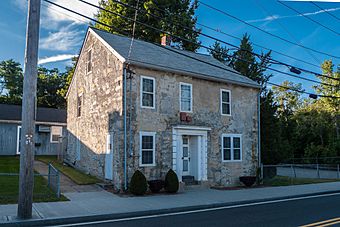Allenville Mill Storehouse facts for kids
Quick facts for kids |
|
|
Allenville Mill Storehouse
|
|

Allenville Mill Storehouse in 2013
|
|
| Location | Esmond, Rhode Island |
|---|---|
| Built | 1813 |
| NRHP reference No. | 72000033 |
| Added to NRHP | January 20, 1972 |
The Allenville Mill Storehouse (also known as the Company Storehouse or just Allenville) is a historic building in Esmond, Rhode Island. It's located within the town of Smithfield, Rhode Island. We don't know the exact year it was built. But it was constructed with strong stone walls, a common way to build mills around the time of the War of 1812. In 1813, a man named Phillip Allen bought some land and started building a mill there. The first clear mention of this specific storehouse was in an insurance paper from 1836.
Allen sold the property in 1857. After that, it changed owners several times. In 1906, it became part of Esmond Mills. Later, in 1937, the building was even used as a post office. People often mistakenly called it the "Old Allenville Mill." The building has had some changes, like to its front door. The Allenville Mill Storehouse was added to the National Register of Historic Places in 1972. This means it's recognized as an important historical site.
A Look Back: Its History
The Allenville Mill Storehouse is a two-story stone building. It measures about 30 feet (9 meters) on each side. Phillip Allen had it built. The exact date it was finished is a bit of a mystery. However, its stone construction was typical for mill buildings during and after the War of 1812.
In 1813, Allen bought 4.5 acres of land from Esek Smith. He planned to build a mill there. While we don't know the exact construction date for the mill and storehouse, Allen's brother, Zachariah, wrote in his diary about a payment to "P. Allen for building his factory" on March 5, 1821.
The first official record that clearly mentions this building is from an 1836 insurance policy. Philip Allen got this policy for his cotton factory. It also listed a "Store and cloth room." This suggests the building was used as a storehouse. More proof comes from an old map from 1858 and town records.
Allen sold the property in 1857. It changed hands again in 1860 and was renamed the Smithfield Manufacturing Company. It changed owners once more in 1879, becoming Enfield Mills. Then, in 1906, it was sold again and renamed Esmond Mills.
In 1937, the building served as a post office. At that time, people wrongly called it the "Old Allenville Mill." It wasn't until a survey for the National Register of Historic Places that experts realized it was actually the storehouse, not the main mill.
Building Changes Over Time
In 1971, when the building was nominated for the National Register of Historic Places, experts noted some changes. For example, a window on the first floor of the front side had been made larger. These changes might have happened in the late 1800s or early 1900s. This was around the time the building became a United States Post Office.
One change seems to be a side entrance on the southwest part of the building. Some experts think this new door might have replaced an old window. The main entrance also looks different now. It has a flat, decorative frame with columns. This new main entrance adds an important visual touch to the simple building.
In 1971, the inside of the building wasn't described in detail. A photo from that time showed the windows were boarded up, and the building was listed for rent. However, a photo from 2013 shows that the building has been fixed up and is still in good shape today.
Why This Building Is Important
For a long time, people thought the Allenville Mill Storehouse was the actual Allenville Mill. Even a book from 1937 called it that. But records show this building was the storehouse for the mill that was built in 1813.
Even though it wasn't the main mill, the storehouse is very important. It's the oldest surviving example of a 19th-century company storehouse in Rhode Island. It's also one of only a few company storehouses from the 1800s that are still standing.
Plus, the property was built and owned by Phillip Allen. He was a very important person. He later became the Governor of Rhode Island and then a United States Senator. Because of its history and unique survival, the Allenville Mill Storehouse was added to the National Register of Historic Places in 1972.



